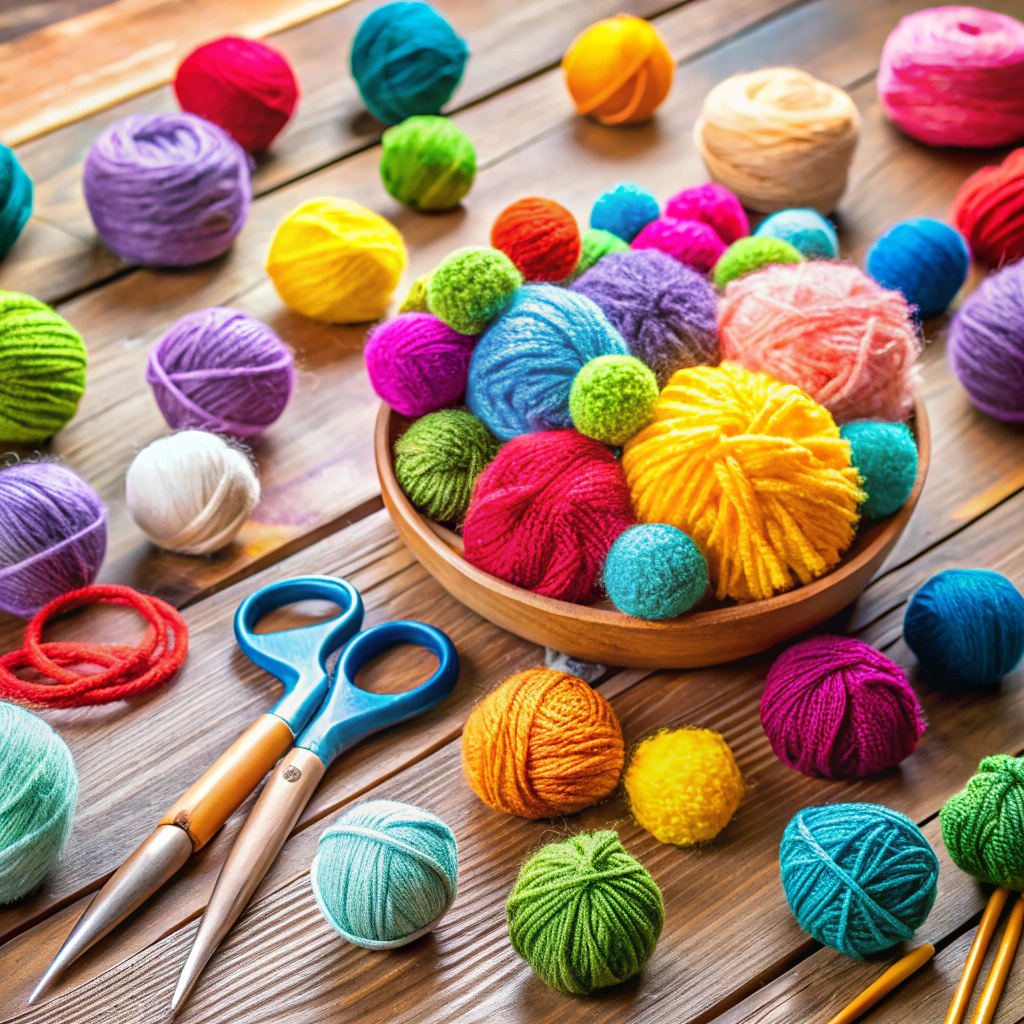Discover the cozy world of yarn sweaters as we explore various types, textures, and styles that will keep you warm and fashionable all year round.
Are you a fan of cozy sweaters? Do you love the feel of soft yarn against your skin? If so, then this blog post is for you! Today, we’re going to explore the different types of yarn that are commonly used to make sweaters. Whether you prefer a chunky knit or something more delicate, there’s a type of yarn out there that will suit your needs.
So grab your favorite cup of tea and settle in for some cozy sweater talk!
Fiber Content
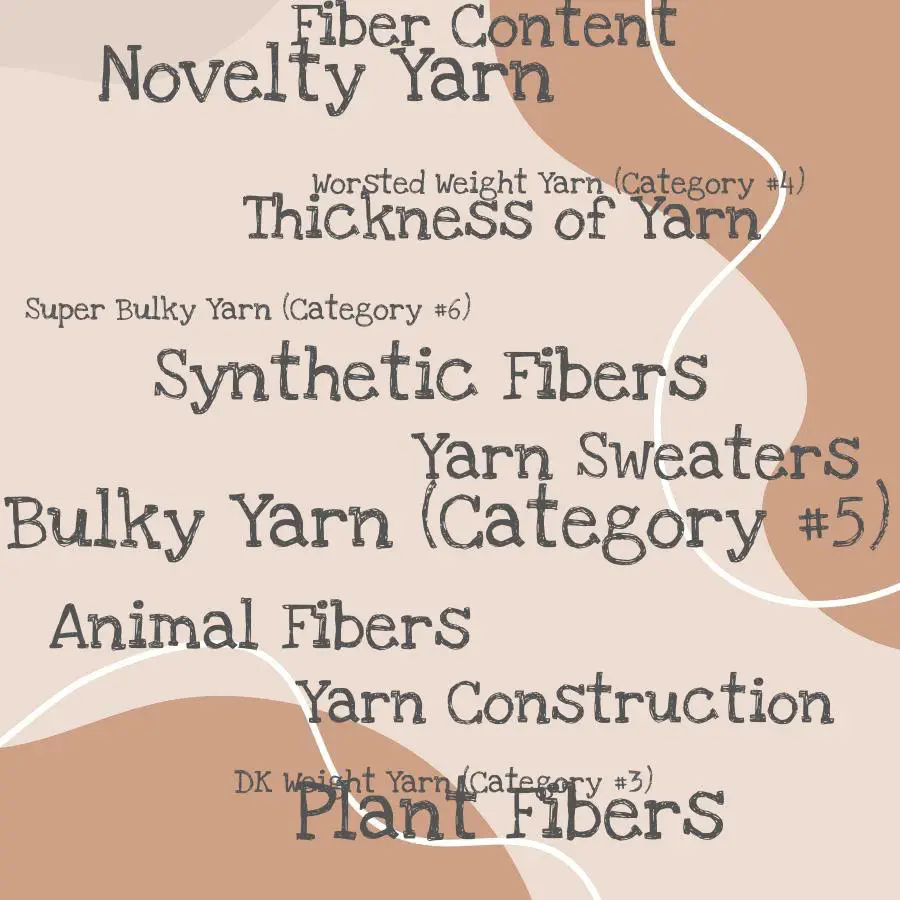
Different fibers have different properties that affect how a sweater feels, drapes, and wears over time.
Animal fibers like wool and alpaca are popular choices for sweaters because they’re warm, soft, and durable. Wool is particularly good at regulating body temperature by wicking away moisture from the skin while still insulating against cold air.
Alpaca has similar qualities but with a smoother texture that’s less likely to cause itching or irritation.
Plant-based fibers like cotton and linen are lightweight options that work well in warmer climates or as layering pieces under heavier garments. They tend to be more breathable than animal fibers but may not provide as much warmth in colder temperatures.
Synthetic materials like acrylics can mimic natural fiber textures while being more affordable and easier to care for than their counterparts. However, they don’t always hold up as well over time compared with natural materials.
Blends of different types of yarn can offer unique combinations of properties such as warmth plus breathability or durability plus softness depending on what you’re looking for in your finished garment.
Animal Fibers
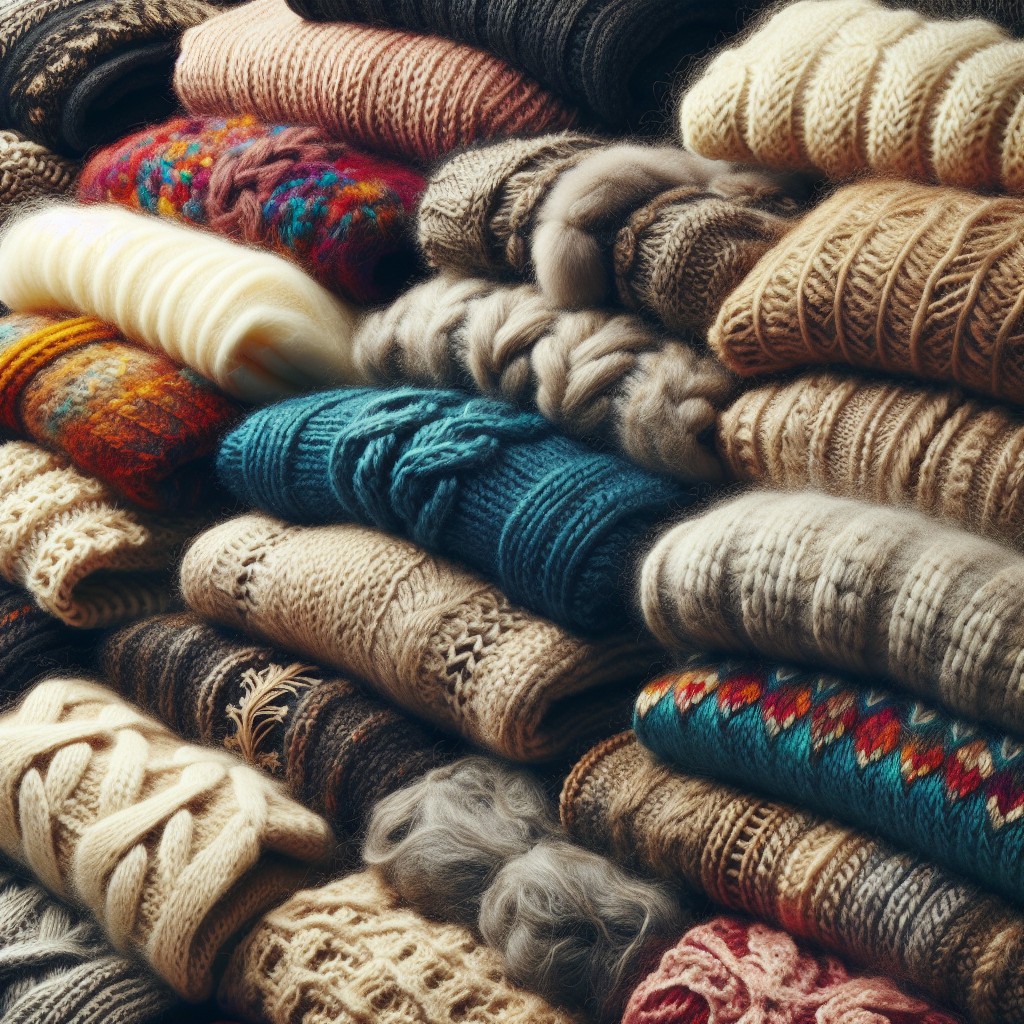
These fibers come from animals such as sheep, alpaca, cashmere goats, and even rabbits. Wool is the most common type of animal fiber used in sweaters because it’s soft yet durable.
It also has natural insulating properties that make it perfect for cold weather wear.
Alpaca fiber is another popular option due to its silky texture and hypoallergenic qualities. Cashmere goat hair produces one of the softest yarns available but can be quite expensive due to its rarity.
When choosing an animal fiber for your sweater project, consider factors like warmth level needed (some wool types are warmer than others), itchiness (some people may have sensitivities), durability (will you be wearing this often?), cost (animal fibers can vary greatly in price), and availability.
Plant Fibers
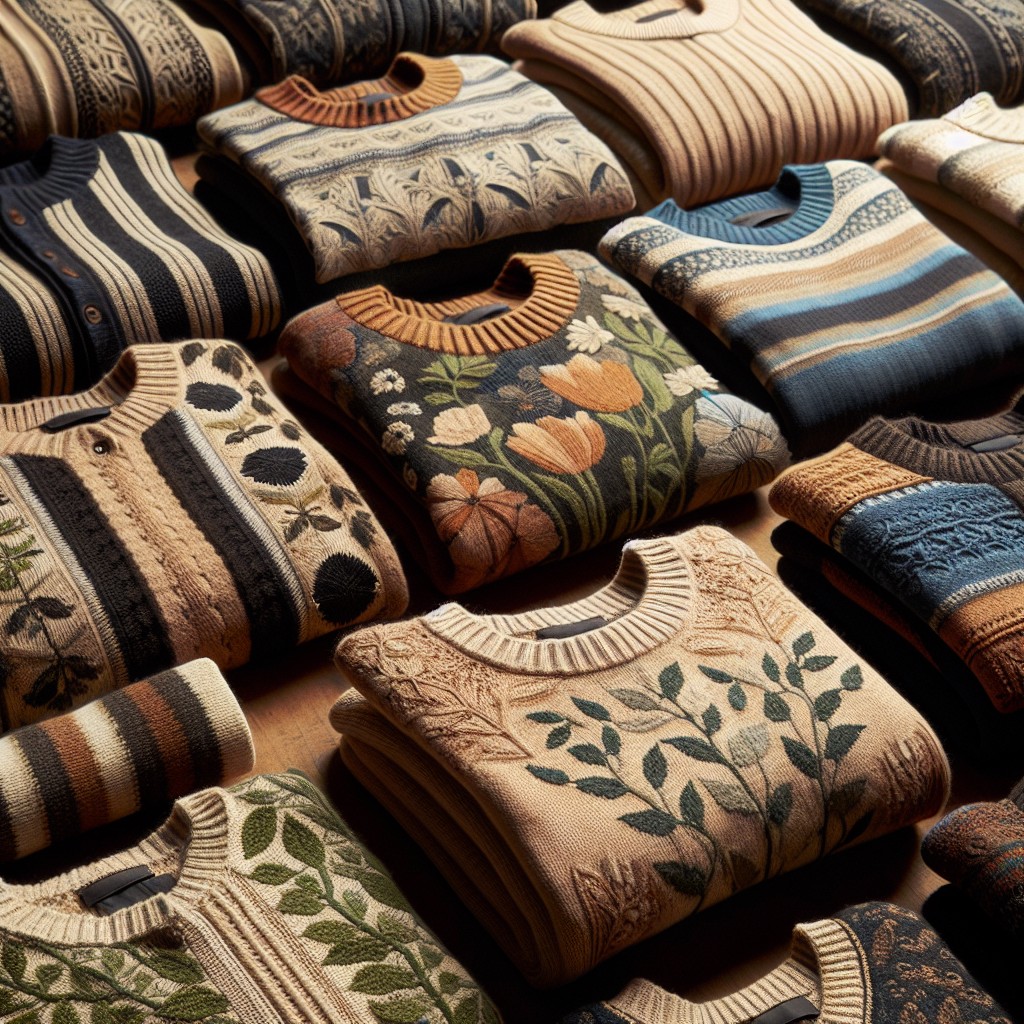
They’re lightweight, breathable, and perfect for warmer weather. Cotton is one of the most common plant fibers used in yarn production and it’s easy to care for as well.
It can be machine washed and dried without any issues.
Another popular plant fiber is linen which has been used since ancient times due to its durability and strength. Linen yarns have a unique texture that softens with each wash making them ideal for summer garments.
Bamboo is another great option if you’re looking for something eco-friendly as it grows quickly without the need of pesticides or fertilizers. Bamboo yarns are silky smooth with excellent drape making them perfect choices when creating shawls or scarves.
Lastly, hemp offers an environmentally friendly alternative to cotton that requires less water during cultivation while still producing strong durable fibers suitable not only in clothing but also home decor items like rugs or baskets.
Synthetic Fibers

They are often made from materials like acrylic, nylon, and polyester. These fibers can be very soft and comfortable to wear but may not have the same breathability as natural fibers.
However, they do offer some advantages over natural yarns such as being easy to care for and resistant to shrinking or stretching out of shape.
Acrylic is one of the most popular synthetic yarns used in sweater making because it’s inexpensive yet still provides warmth without weighing you down. It also comes in many colors which makes it perfect for creating bright or bold designs.
Nylon is another common synthetic fiber that’s known for its strength and durability while providing excellent elasticity which helps keep your sweater fitting snugly even after multiple wears.
Polyester is an incredibly versatile material that can mimic almost any type of fiber including wool or cotton while being much cheaper than those options.
Blends
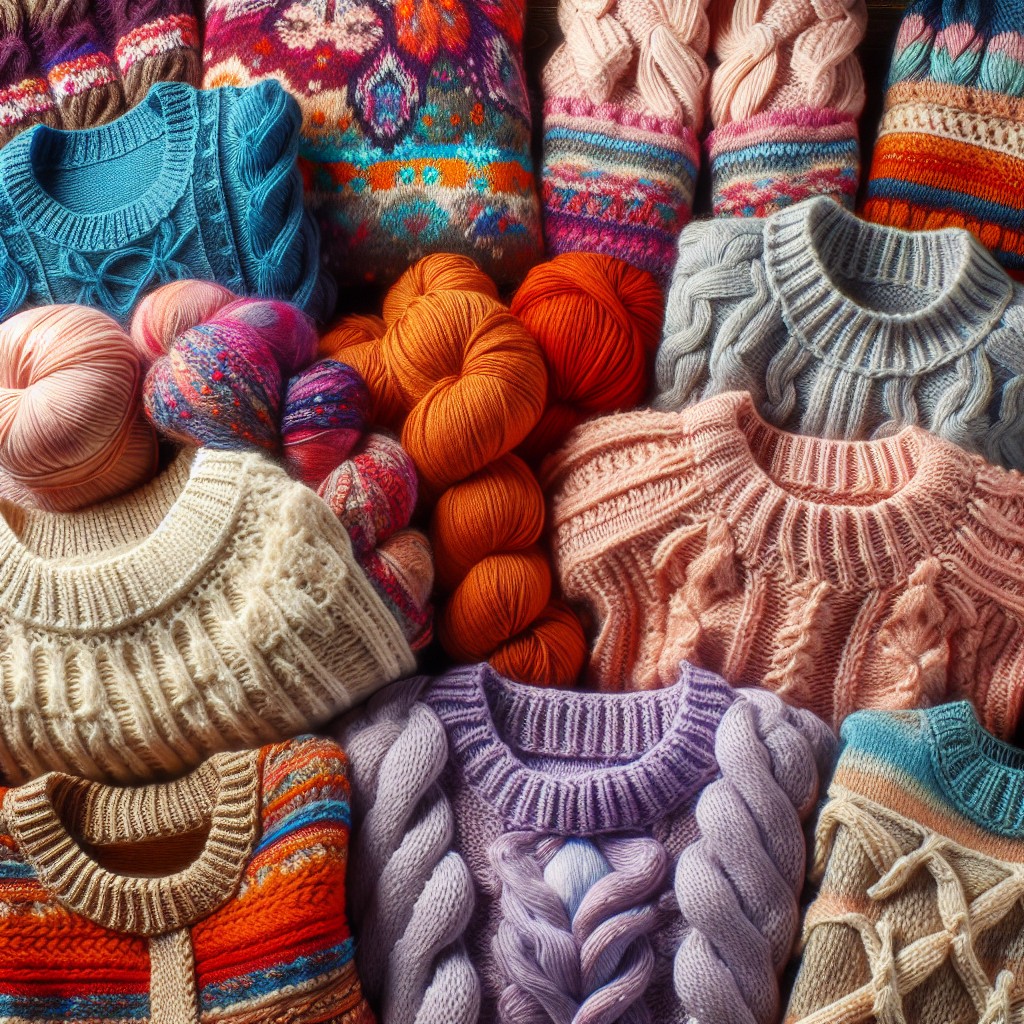
For example, a blend of wool and acrylic can be warm, soft, and easy to care for. Blends can also add texture or visual interest to your sweater project.
When choosing a blend yarn for your sweater project, consider the fiber content carefully. Some blends may not be suitable if you have sensitive skin or allergies to certain fibers.
It’s also important to check the care instructions as some blends may require special handling.
Care Instructions
Different types of yarn require different care instructions, so be sure to read the label carefully before washing or drying your garment. Some fibers can be machine washed and dried on low heat, while others need to be hand-washed and laid flat to dry.
If you’re unsure about how best to care for your sweater, a good rule of thumb is always erring on the side of caution. Handwashing in cold water with a gentle detergent is usually safe for most types of yarns.
Avoid using fabric softeners as they can damage natural fibers like wool.
When drying sweaters made from animal fibers such as wool or alpaca, avoid wringing them out as this can cause stretching and distortion in their shape; instead gently squeeze out excess water by pressing between towels before laying flat on a clean surface away from direct sunlight until completely dry.
Yarn Construction
There are two main types of yarn construction: plied and single-ply.
Plied yarns are made by twisting multiple strands of fiber together. This creates a stronger, more durable yarn that is less likely to pill or fuzz over time.
Plied yarns also tend to be smoother and more even in texture, making them ideal for intricate stitch patterns.
Single-ply yarns, on the other hand, are made from just one strand of fiber that has been spun tightly together. These types of yarns tend to be softer and fluffier than plied varieties but may not hold up as well over time.
When choosing a type of construction for your sweater project, consider what kind of look you’re going for as well as how much wear-and-tear you expect it will endure.
Thickness of Yarn
The thickness of a yarn is often referred to as its weight and can range from super fine (category #1) all the way up to super bulky (category #6).
If you’re looking for a lightweight sweater that’s perfect for layering, then you’ll want to choose a thinner yarn like category #3 or 4. These weights are great for creating delicate stitches and intricate patterns.
On the other hand, if you’re looking for something more substantial that will keep you warm on even the coldest days of winter, then opt-in thicker categories such as 5 or 6. These heavier weights create chunky knits with lots of texture.
It’s also worth noting that different types of fibers can affect how thick or thin a particular weight category feels when worked up into fabric. For example, wool tends to be springier than cotton and may produce slightly bulkier results in some cases.
Color
The right color can make all the difference in how you feel wearing it. If you’re making a sweater for yourself, consider what colors look best on you and what will complement your existing wardrobe.
If the sweater is a gift, think about the recipient’s favorite colors or their personal style.
When selecting yarn based on color, keep in mind that some fibers take dye better than others. For example, wool tends to absorb dye more readily than cotton or acrylic fibers do.
This means that wool yarns are available in a wider range of vibrant hues and deep shades.
Another thing to consider when choosing color is whether you want your sweater to be solid-colored or have variegated tones throughout it? Variegated yarns can add interest and texture to simple patterns but may not work well with more complex designs.
What Kind of Sweater You Would Like to Make
Are you looking for something lightweight and airy or thick and cozy? Do you want a fitted silhouette or an oversized, slouchy look? The type of yarn that will work best for your project depends on these factors.
For example, if you’re making a summer sweater, cotton or linen might be the perfect choice. These fibers are breathable and lightweight which makes them ideal for warmer weather.
On the other hand, if it’s winter time and warmth is your top priority then wool is an excellent option as it provides insulation while still being soft against skin.
If texture is important in creating your desired look then mohair can add some fluffiness while alpaca adds drape with its silky feel. If durability matters most when selecting materials then acrylic may be more suitable since this fiber holds up well over time without pilling easily.
DK Weight Yarn (Category #3)
It’s slightly thicker than sport weight yarn but not as thick as worsted weight. This makes it perfect for lightweight sweaters that can be worn in the spring or fall.
One of the benefits of using DK weight yarn is that it comes in a variety of fibers such as wool, cotton, and acrylic. Wool DK yarns are great for warm winter sweaters while cotton and acrylic blends work well for lighter garments.
When choosing your DK weight yarn, consider the color options available to you. Since this type of yarn isn’t too thick or thin, it’s easy to create intricate patterns with multiple colors without overwhelming your design.
Worsted Weight Yarn (Category #4)
It’s versatile, easy to work with, and comes in a wide range of colors. This type of yarn falls into category #4 on the standard yarn weight system and is slightly thicker than DK weight.
One great thing about worsted weight yarn is that it works well for both beginner and advanced crocheters alike. Its thickness makes it easy to see your stitches as you work, which can be helpful if you’re just starting out or trying a new stitch pattern.
Another benefit of worsted weight yarn is its availability – most craft stores carry this type of yarn in abundance! You’ll find plenty of options when it comes to fiber content too; wool blends are common but there are also many acrylic options available.
When choosing worsted weight for your sweater project, consider the drape you want your finished garment to have. A tighter gauge will create more structure while looser gauges will give more flowy results.
Bulky Yarn (Category #5)
This type of yarn is thicker than worsted weight and creates larger stitches with fewer rows. Bulky weight sweaters are perfect for colder weather as they provide extra warmth.
When choosing bulky yarns, consider the fiber content carefully. Wool or wool blends are great choices as they have natural insulating properties that will keep you warm even in freezing temperatures.
Acrylic fibers can also be used but may not provide the same level of warmth.
Another thing to consider when using bulky weight yarns is your pattern choice. Simple stitch patterns like garter stitch or stockinette work well with this type of thick and chunky material because it allows the texture of the fabric to shine through without being too busy.
Super Bulky Yarn (Category #6)
This type of yarn is perfect for those who want to make something fast but still have it look stylish and modern.
Super bulky yarns are typically made from wool or acrylic fibers and come in a variety of colors. They are also great for making blankets, scarves, hats, and other winter accessories.
When working with super bulky yarns, keep in mind that they can be quite heavy. You may need larger needles or hooks than what’s recommended on the label to achieve your desired gauge.
Also note that because this type of yarn creates such thick fabric when knitted up; it may not be suitable for all patterns.
Novelty Yarn
Novelty yarns come in a variety of textures, colors, and styles that can add an extra dimension to your sweater. Some popular types of novelty yarn include boucle (which has loops that create a textured look), eyelash (which has long strands that resemble lashes), and ribbon (which is made from thin strips of fabric).
Keep in mind though; these types of yarn are not always easy to work with as they can be challenging to see the stitches or count rows accurately.
When working with novelty yarns, it’s essential to choose the right pattern so as not to overwhelm the texture or color variations. A simple stitch pattern like stockinette stitch will allow the unique qualities of this type of fiber shine through without being too busy.
Yarn Weight
Yarn weight refers to the thickness of the yarn and can range from super fine (also known as lace weight) all the way up to super bulky. The type of yarn you choose will depend on what kind of sweater you want to make and how warm or lightweight you want it.
For example, if you’re making a delicate summer top, then a light fingering-weight cotton or bamboo blend might be perfect. On the other hand, if you’re looking for something cozy and warm for winter weather, then a chunky wool or alpaca blend would be ideal.
It’s also worth noting that different weights require different hook sizes or needle sizes when crocheting/knitting with them. So before starting your project make sure that your hook/needle size matches with recommended gauge in pattern instructions.
Cost
The price of yarn can vary greatly depending on the fiber content, thickness, and brand. While some luxury fibers like cashmere or alpaca may be tempting, they can also come with a hefty price tag.
On the other hand, acrylic or cotton blends are often more affordable options.
When deciding on a budget for your sweater project, it’s essential to keep in mind how much yarn you’ll need based on the pattern you’re using and its size requirements. It’s always better to buy slightly more than what you think you’ll need just in case.
If cost is a significant concern for your project but still want high-quality materials that won’t break the bank? Consider looking into wool blends or synthetic fibers that mimic natural ones without sacrificing quality while keeping costs down.
Availability
Some types of yarn may be more readily available in certain areas or online stores than others. It’s always a good idea to check with your local craft store or search online before settling on a specific type of yarn.
If you’re looking for something unique and hard-to-find, specialty shops and independent sellers are great places to start. They often carry rare fibers that can add character and texture to your project.
However, keep in mind that some specialty fibers may come at a higher cost than more common options. If budget is a concern, sticking with widely available brands might be the best option.
What Season Are You Crocheting This Sweater?
If you’re making a sweater for fall or winter, then thicker yarns like bulky and super bulky are great choices as they will keep you warm during colder months. On the other hand, if your goal is to make something for spring or summer, lighter weight yarns such as DK weight and worsted weight are more suitable options.
For warmer weather sweaters, cotton and linen fibers work well because they breathe easily and don’t trap heat against your skin. These fibers also tend not to pill as much over time compared with woolen ones.
Choosing Yarn for Children’s Sweaters
First and foremost, you want something that is soft and comfortable against their delicate skin. Look for yarns made from natural fibers like cotton or wool blends that won’t irritate their skin.
Another important factor to consider is durability. Children can be tough on clothes, so you’ll want a yarn that can stand up to wear and tear without losing its shape or color.
Think about the season when your child will be wearing the sweater. For colder months, opt for thicker yarns like bulky or super bulky weight; while lighter weights such as DK weight would work well during warmer seasons.
Choosing Yarn for Selling Sweaters
You want to make sure that the yarn you use will not only look and feel great but also hold up well over time. When selecting a yarn for selling sweaters, consider using high-quality natural fibers such as wool or alpaca.
These fibers are durable and have excellent insulating properties, making them perfect for cold weather garments.
Another factor to consider when choosing yarns for selling sweaters is color selection. Neutral colors like black, white or gray tend to be popular choices because they can easily match with any outfit while brighter hues may appeal more towards younger customers.
Which Fibers Work for Your Lifestyle?
If you’re someone who is always on the go and doesn’t have a lot of time for hand-washing delicate fabrics, then synthetic fibers or blends may be a better choice. These types of yarns are often machine washable and dry quickly.
On the other hand, if you enjoy taking care of your garments by hand washing them with gentle detergent and laying them flat to dry, then natural fibers like wool or cotton may be more suitable for you. Not only do these fibers require special care but they also offer unique benefits such as breathability in warm weather (cotton) or warmth in cold weather (wool).
If sustainability is important to you, there are eco-friendly options available such as bamboo or recycled materials that can make beautiful sweaters while reducing environmental impact.
Most Common Fiber Types
Wool is one of the most popular fibers used in sweater-making due to its warmth and durability. It’s also naturally water-resistant, making it perfect for outdoor wear.
Cotton is another popular choice as it’s soft and breathable, making it ideal for warmer weather or indoor wear. Acrylic yarns are often chosen because they’re affordable and easy to care for – just toss them in the washing machine! Alpaca wool is known for being incredibly soft while still providing warmth.
Other animal fibers like cashmere, mohair, and angora can add luxury to your sweater but may require special care instructions due to their delicate nature.
Plant-based fibers like bamboo or linen can provide a lightweight option with excellent drape while synthetic blends offer affordability without sacrificing quality.
Ease of Care
Some fibers require special handling and can be difficult to clean, while others are machine washable and dryable. If you’re making a sweater for yourself or someone who doesn’t have the time or patience for hand-washing delicate fabrics, then synthetic blends may be a good choice.
These types of yarns are often easy-care and can withstand multiple washings without losing their shape or color.
On the other hand, if you prefer natural fibers like wool or cotton but still want something that’s easy to care for, look for superwash wool or mercerized cotton options. Superwash wool has been treated so that it won’t felt when washed in a machine on gentle cycle with cold water; while mercerized cotton has been chemically treated so that it’s stronger than regular cotton fiber.
Ultimately, ease of care will depend on your personal preferences as well as how much time you’re willing to spend maintaining your garment over its lifetime.
Your Pattern
Different patterns will require different types of yarn, so make sure you read through the instructions carefully before making a decision. Some patterns may call for a specific weight or type of yarn, while others may allow more flexibility.
If you’re creating your own pattern or modifying an existing one, keep in mind that certain fibers and weights will work better than others depending on what kind of stitch pattern you’re using. For example, if your sweater has intricate lacework or cables that need to stand out prominently from the background fabric then thinner weight yarns with good stitch definition are ideal.
On the other hand, if your design features simple stitches like stockinette or garter stitch then thicker and fluffier fibers can add texture and interest without detracting from those basic stitches.
Who Is This Crochet Sweater For?
Are you crocheting a sweater for yourself or someone else? If so, think about their lifestyle and preferences. For example, if you’re making a sweater for an active person who spends a lot of time outdoors, then wool or alpaca might be good choices because they are warm and durable.
On the other hand, if you’re making a sweater as a gift for someone with sensitive skin or allergies to animal fibers like wool or mohair then cotton would be an excellent choice since it is hypoallergenic.
If this crochet project is intended as part of your business venture (selling sweaters), keep in mind that some customers may prefer natural fibers while others may prioritize affordability over fiber content. Therefore understanding what kind of people will buy from your store can help guide which types of yarns to stock up on.
What Is Your Budget?
Yarn can range from a few dollars per skein to over $50 depending on the fiber content and brand. If you’re on a tight budget, there are plenty of affordable options available that still offer great quality.
Acrylic yarn is one of the most affordable types of yarn and can be found in almost any craft store. It’s also easy-care, making it perfect for everyday wear or children’s sweaters that may need frequent washing.
Wool blends are another great option if you’re looking for something warm but don’t want to break the bank. These blends often combine wool with acrylic or other synthetic fibers which make them more durable and easier to care for than pure wool.
If you have a larger budget, luxury fibers like cashmere or alpaca will give your sweater an extra touch of softness and warmth but come at a higher price point.
Yarns I Love & Recommend
Some have been great, while others not so much. So here are some of my favorite yarns that I love and recommend for making sweaters.
First on my list is Malabrigo Rios – a superwash merino wool that comes in an array of beautiful colors. It’s soft to the touch and has excellent stitch definition which makes it perfect for cables or textured patterns.
Next up is Cascade 220 Superwash – another versatile option made from 100% superwash wool with a wide range of colors available at an affordable price point.
For those who prefer plant-based fibers, Berroco Modern Cotton DK is an excellent choice as it combines cotton with rayon to create a lightweight yet durable fabric suitable for warmer weather garments.
If you’re looking for something more luxurious, then consider using Madelinetosh Tosh Merino Light – this single-ply fingering weight merino wool has stunning colorways that will make any sweater stand out from the crowd!.
For Fall & Winter
Wool is a popular choice for sweaters because it’s naturally insulating and can keep you warm even in the coldest temperatures. Alpaca is another great option as it’s incredibly soft and has excellent heat retention properties.
If you’re looking for something more budget-friendly, acrylic yarns are a good choice as they’re affordable yet still provide warmth. You can also opt for blends of wool or alpaca with synthetic fibers like nylon or polyester to get the best of both worlds – warmth and durability.
When choosing colors for your fall/winter sweater, think about earthy tones like browns, greens, oranges, reds – these colors will complement the season perfectly! And don’t forget about texture – cables or other intricate stitch patterns add depth to your sweater while keeping things interesting.
For Spring & Summer
Cotton is a popular choice for warm weather sweaters because it’s soft, durable, and easy to care for. Linen is another great option as it has a beautiful drape and keeps you cool in hot temperatures.
If you’re looking for something with more texture or visual interest, consider using bamboo yarn which has a silky feel or try out some of the newer plant-based fibers like Tencel or Modal.
When choosing colors for your spring/summer sweater project think about bright hues such as pastels that will complement the season’s sunny days. You can also opt-in on lighter shades of neutral tones like beige or cream if bold colors aren’t your thing.
Overall when selecting yarns during this time of year keep in mind what feels comfortable against your skin while still being stylish enough to wear out on those breezy summer nights!.
FAQ
What type of yarn is best for sweater?
The best type of yarn for a sweater is acrylic, polyester, superwash wool, or fiber blends, as they are easy to care for, comfortable on the skin, and budget-friendly.
What is the best yarn thickness for sweaters?
The best yarn thickness for sweaters is #5 bulky weight yarn, as it is thicker than #4 medium weight yarn and provides warmth.
What are the differences between natural and synthetic yarns for sweaters?
Natural yarns for sweaters are made from organic materials like wool or cotton, while synthetic yarns are created from man-made materials such as acrylic or polyester.
How does yarn material affect the warmth and comfort of a sweater?
"The warmth and comfort of a sweater are influenced by the yarn material, as it determines factors such as insulation, breathability, and softness."
What factors should be considered when choosing yarn for knitting a sweater?
"When choosing yarn for knitting a sweater, consider factors such as fiber content, weight, texture, color, washability, and personal preferences."
